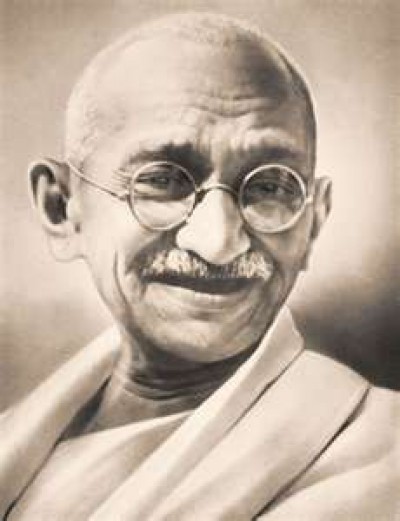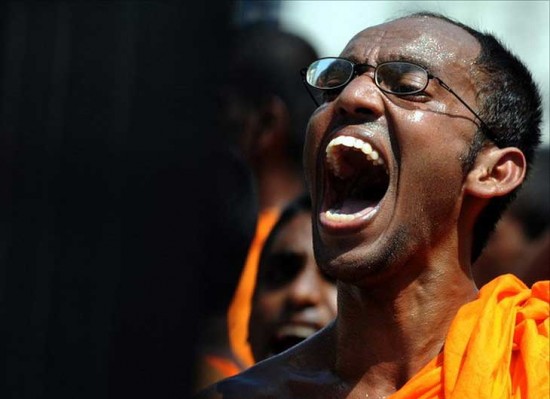Rethinking Patriotism; Re-imaging the Patriot
In honour of ‘Shanie’ (Lankanesan Nesiah)
“There can be no patriotism without justice… As soon as the right of one individual is violated, the right of everyone is jeopardised”.
– Georges Clemenceau
In the morning of January 13th 1948, Mahatma Gandhi began the final fast of his life.
The target of Gandhi’s last fast was not the Colonial rulers but the government and people of newly independent India. His demands were equally unusual. Gandhi wanted Hindu refugees to vacate the Muslim homes/mosques
they had seized, even if it meant returning to the wretched refugee camps, in the bitter cold of Delhi-winter. He also wanted Indian government pay Rs.550 million it owed to Pakistan. Nehru and Patel were withholding the payment because they knew that some of the money would be used by Jinnah to buy weapons to be used against India; they also feared Hindu/Sikh fury.
Gandhi’s conditions caused consternation; many of his followers (in the polity and in society) believed they were anti-Hindu and anti-Indian. But the Mahatma understood that he was fighting for the honour of India and the moral integrity of her Hindus. And as the fast continued, the political/public mood started changing. “The loss of Mahatma Gandhi’s life would mean the loss of India’s soul” Nehru told his people, and they began to agree.
The fast ended successfully. Indian government released the payment to Pakistan. Hindu refugees gave up Moslem dwellings/mosques voluntarily. A political-civic agreement was reached to end the boycott of Muslim shops and to guarantee the safety of Delhi’s Muslims.
Gandhi’s next plan, walking to Pakistan leading a mass of Hindu refugees and returning to India leading a mass of Muslim refugees, never materialised. He was assassinated just 11 days after he concluded his fast.
Hearing about Gandhi’s murder a horrified Mary McCarthy wondered how, “Any man could look into the face of this extraordinary person and deliberately pull a trigger” . In his trial-statement Naturam Godse explained how he was able to murder India’s Great Soul: “My respect for the Mahatma was deep and deathless. It therefore gave me no pleasure to kill him…. My provocation was his constant and consistent pandering to Muslims… I declare here before man and God that in putting an end to Gandhi’s life I have removed one who was a curse to India, a force for evil….a traitor to his faith and his country” .
Both Gandhi and Godse loved India. But there was an unbridgeable gulf between the India Gandhi loved and the India Godse loved. Gandhi’s India was inclusive, the equal home of all her people, irrespective of every difference. Godse’s India was a Hindu Raj in which non-Hindus could live only on sufferance.
There was room for Godse in Gandhi’s India, but there was no room for the Mahatma in Godse’s India.
So who was the real patriot: Mahatma Gandhi or his killer?
What is Our Patria?
The nature of patriotism depends on one’s vision of what ‘Patria’ is. For those who share Godse’s vision of India, Godse is the patriot, and Gandhi the traitor.
Sri Lanka is a politico-geographical reality. But Lankan nation is a politico-ideological abstraction. We are Sri Lankan only in our passports.
In the absence of a Lankan nation there cannot be a Lankan patriotism. What passes off as Lankan patriotism is a
Sinhala-Buddhist patriotism, based on the belief that Sri Lanka is the sole patrimony of its ethno-religious majority. In this hierarchical nation, minorities can live only if they accept their subordinate locus willingly.
We, the Sinhala-Buddhists, expect minorities to overcome their own particularist identities and feelings while we cling to our own. We, the Sinhala-Buddhists, expect minorities to accept, respect and defend our particularist interests as ‘patriotism’.
Those who do so, willingly and unquestioningly are deemed patriotic; those who refuse are vilified as traitors.
The Rajapaksas have added another layer of lethality to this racialist-vision – the ‘axiom’, that only the Ruling Siblings can protect Sinhala-Buddhist Sri Lanka from its internal and external enemies. The defeating of the LTTE sans any political/humanitarian concessions to the Tamils is used to buttress this claim of ‘Rajapaksa-supremacism’ within an overall context of Sinhala-Buddhist supremacism.
Once Rajapaksa interests become coterminous with national interests, all Rajapaksa opponents can be condemned as traitors.
In Vellupillai Pirapaharan’s universe, treachery was omnipresent – because any word of criticism, any act of dissent was considered a betrayal of Eelam. Whatever the Leader decided to do ‘in the pursuit of Eelam’ was deemed good and just, and therefore, deserving of unconditional support (including such abominations as child conscription).
In the Rajapaksa-universe too, treachery is omnipotent. Patriotism is equated with uncritical support of Sri Lanka and unquestioning obedience to her rulers. Consequently a whole range of normal political acts and human impulses are decried as unpatriotic – from criticising Rajapaksa plans/deeds to asking Basil and Gotabhaya Rajapaksa why they retain their American citizenships, from mourning the ‘unworthy-dead’ to fighting for justice for the victims of Rajapaksa Rule, from demanding the closure of a factory belonging to a Rajapaksa stooge to opposing the latest Rajapaksa insanity – a plan to introduce religious censorship .
Since nation is equated with the Ruling family, a ‘traitor’ can become a ‘patriot’ instantaneously by becoming a Rajapaksa-votive; a ‘patriot’ will lapse into treachery the moment he/she leaves the Rajapaksa fold (thus, KP the Patriot and Gen. Fonseka the Traitor).
Patriotism is turned into not only a political-religion but also a fundamentalist one, with the Rajapaksas as its prophets.
The communalist-familial version of patriotism currently hegemonic in Sri Lanka is one of the most effective politico-ideological tools of Rajapaksa Rule. Dissecting and discarding this notion of patriotism and replacing it with an inclusive, equal and democratic version is a necessary precondition for any successful anti-Rajapaksa project. Sans such an alternative vision of ‘Patria’ and ‘patriotism’, the Rajapaksas will be able to discredit/destroy any dissenter by the simple expedient of calling him/her a traitor.
A country is not infallible; as Rabindranath Tagore stated, “countries are not always true to themselves” . Nor are there any pure races/religions/cultures; every race/religion/culture has been shaped and changed by cross-pollination. The equation of national criticism with national betrayal is a profoundly false one. Citizens have a right – and a responsibility – to criticise their country if they think it is acting unjustly or inanely.
A nation which is incapable of acknowledging and correcting its own errors places itself at risk. Sri Lanka is a far more fragmented country today than it was even at the height of Tiger-power because the Rajapaksas – in furtherance of their familial-dynastic project – have imposed a monolithic (Sinhala-Buddhist) identity on an extremely pluralist land. This version of patriotism will turn differences into fault-lines and transform disagreements into violent conflicts.
A country mired in an unending vortex of violence will suit Rajapaksa-needs but not the interests/needs of any ordinary Lankan.
**
‘Shanie’ in his Notebooks turned the microscope inwards and called things by their proper names. He was a patriot of a Sri Lanka that could and should have been, but never was.
It is only in a Patria which is just, equal, democratic and tolerant (a la Shanie) that the dream of a lasting peace and humane development


